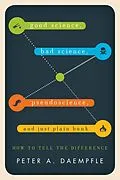We are constantly bombarded with breaking scientific news in the media, but we are almost never provided with enough information to assess the truth of these claims. Does drinking coffee really cause cancer? Does bisphenol-A in our tin can linings really cause reproductive damage? Good Science, Bad Science, Pseudoscience, and Just Plain Bunk teaches readers how to think like a scientist to question claims like these more critically.
Peter A. Daempfle introduces readers to the basics of scientific inquiry, defining what science is and how it can be misused. Through provocative real-world examples, the book helps readers acquire the tools needed to distinguish scientific truth from myth. The book celebrates science and its role in society while building scientific literacy.
Autorentext
Peter A. Daempfle is associate professor of biology at SUNY College of Technology at Delhi. He has taught in the sciences for more than 20 years and has served as an advisor in the standards-based reform effort, working to improve national science literacy and to advance the importance of scientific thinking.
Zusammenfassung
Good Science, Bad Science, Pseudoscience, and Just Plain Bunk teaches readers to think like scientiststo critically evaluate the truth of scientific claims. Filled with provocative real-life examples, from the effects of Bisphenol-A to examining some of the alleged causes of cancer, the book helps readers build their tools of scientific literacy.
Inhalt
List of Figures
Preface
I. Science Tools
1: Introduction
2: Science is Arguing
3: Tools Scientists Use
4: Science for Every Person
5: The Role of Critical Thinking
II. Science in Everyday Life
6 : The Media
7: Pseudoscience
8: Debunking Science Myths: Separating Fact from Fluff
9: What are Scientists' Responsibilities?
III. Science: Threats or Compromises
10: Science Progress
11: Getting People to Love Science
12: Driving the Economy through Science
Acknowledgments
About the Author
Glossary
Index
